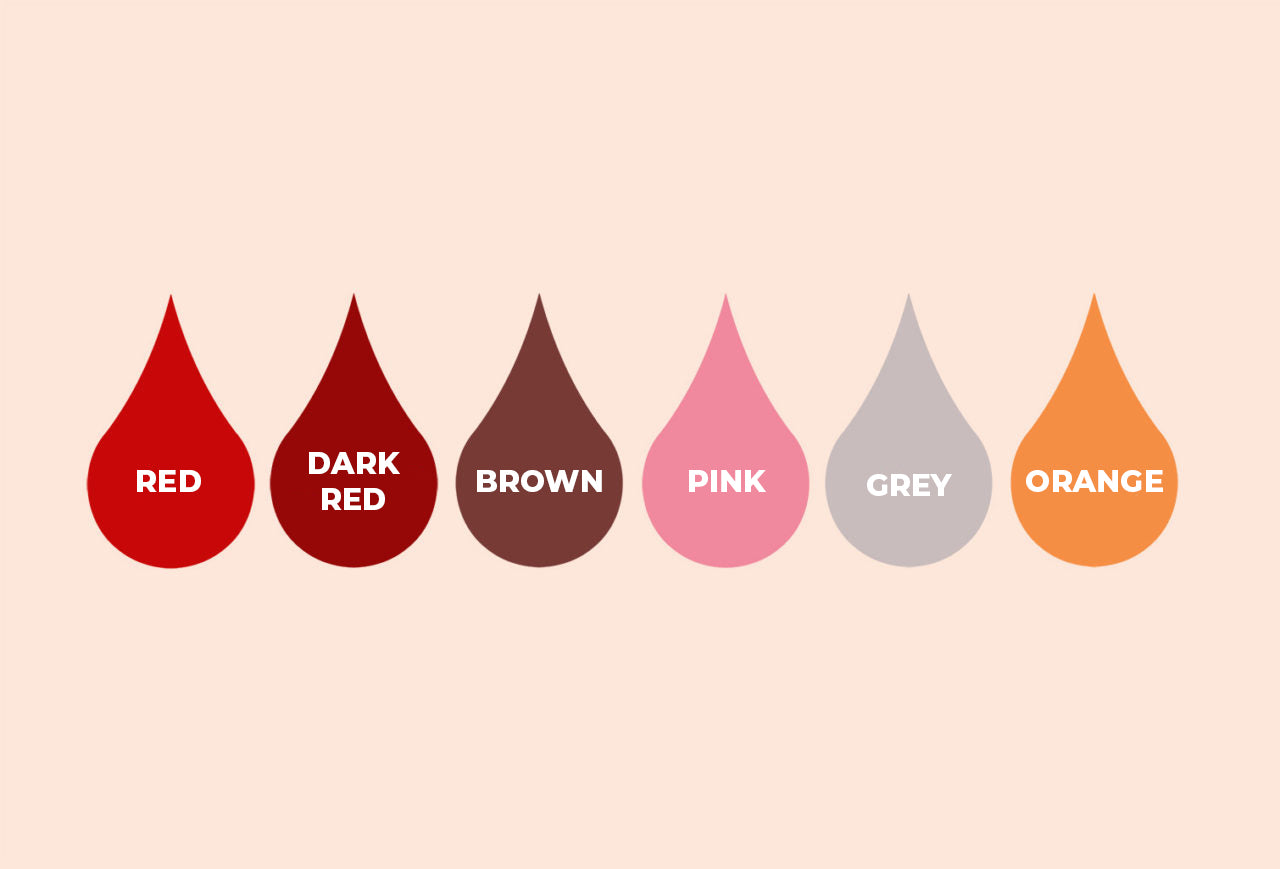What does the colour of your period mean?

Period is your uterus' way of getting rid of the mucous membrane that has grown to receive a fertilised egg. When that doesn't happen, the uterus ejects the mucous membrane as blood, which is your period.
During menstruation, it is common for menstrual blood to change in colour, quantity, and consistency. The colour depends on how long it takes for the blood to leave your body. In the beginning and at the end of your period, when you don’t bleed a lot, your period is usually brownish because the blood is in contact with air for a longer time on its way out of the vagina. This causes the blood to oxidise, which means that the air (oxygen) reacts with the iron in the blood and changes its colour from bright red to brown. When you bleed more, your blood is more red. The appearance of your period can also be affected by hormonal changes and infections, or by using a hormonal contraceptive which can make your period a lighter red or darker brown colour.
Bright red period
The blood is usually bright red during the first few days of menstruation. This is because it comes out in a steady flow. The first few days of your period is also when you tend to bleed the most and when clumps can form. Clumps are a sign of heavy periods and are caused by the body's natural anti-coagulants not being enough which causes the blood to clot. Some people have a bright or light red colour throughout their period, but it is common for it to get darker towards the end of the period.
Dark red period
Dark red periods can have several causes. When we are asleep, the blood does not flow as easy, so in the morning the menstrual blood is usually dark red because it has had time to oxidise in the vagina after sleeping. Menstrual blood can also be dark red because your period is about to end. This is because the menstrual flow is slower at the end and therefore has time to oxidise on the way out.
Brown or black period
Brown or black periods are old blood that has started to oxidise. Brown or black menstrual blood is most common in the beginning and at the end of the menstrual cycle because it takes longer for it to leave the body. If you are pregnant and have brown discharge or bleeding, it may be a sign of miscarriage or ectopic pregnancy. An ectopic pregnancy means that the fertilised egg is attached outside the uterus, for example in one of the fallopian tubes. If this is the case, you often experience small amounts of bleeding combined with pain in the lower part of your abdomen. Please contact your doctor if you are worried.
Bright pink
Bright pink periods are often a cause of the uterine secretions being mixed with the menstrual blood, turning into a lighter colour. It is common for the period to turn this colour at the beginning of the menstrual cycle.
The pink menstrual blood can also be caused by other factors:
- Some women experience pink, blood-mixed discharge during or after sex, as it can create small holes in the mucous membranes.
- Birth control pills that lower oestrogen levels can sometimes result in more sparse bleeding that may be more pink than red.
- Iron deficiency, also called anaemia. It is the iron in the blood that gives the blood its characteristic red colour. If you have iron deficiency, it can cause your menstrual blood to turn pink.
Orange
If your period has an orange colour to it, it may have been mixed with your uterine secretions. It can also be a sign of an infection, a bacterial imbalance in the vagina, or a trichomoniasis infection (a sexually transmitted disease). If your period is orange, you should be alert to other symptoms that indicate a vaginal infection, such as itching, abnormal odour or discomfort. Seek medical care if you are worried.
Grey
Menstrual blood that has a grey tone may be a sign of an infection, such as bacterial vaginosis. Sometimes it can be difficult to detect grey menstrual blood straight away, so it's important to look out for other symptoms, such as an abnormal smell, a burning feeling when you urinate, or itching around and in the vagina.
Bacterial vaginosis occurs as a result of an imbalance in the bacterial flora of the vagina and often needs treatment. Contact your healthcare professional for help with your symptoms.
If you have grey bleeding with blood clots in it, it may be a sign of a miscarriage. If you are worried, you should contact your doctor for further clarification.
Other types of periods
Slimy or clotted period
There may sometimes be blood clots in your period. These clots are old blood that has gathered in the uterus. Clots are a sign of a heavy period and are caused by the body's natural anti-coagulants not being enough, causing the blood to clot. It is more common amongst women with very heavy bleedings (menorrhagia). The body finds it harder to cope with heavy and rapid menstrual bleedings, therefore the blood clots.
Both mucus and clots in menstruation are completely harmless but you should not bleed clots. It may be a sign that you are bleeding too much, i.e. having a too heavy flow, and you should seek medical care and get help.
Intermenstrual bleeding
Intermenstrual bleeding, or spotting, are small bleedings of different colours during or between periods.
Intermenstrual bleedings can have several causes, such as:
- Ovulation
- Wounds on the vaginal wall during or after sex
- Sexually transmitted diseases, such as chlamydia
- Hormonal contraceptives
- Myoma or polyps, i.e. non-cancerous growths in the uterus
- Polycystic ovary syndrome (PCOS)
- Cancer in the cervix, uterus, vagina or vulva
- Low oestrogen levels:
If the body does not produce enough oestrogen, pieces of the mucosa may become loose and eject irregularly, leading to spotting. If your oestrogen levels are too low, you may also experience spotting at any time during your menstrual cycle, it doesn't have to be just before your period. Low oestrogen levels and spotting can mean that you may be in your premenopause.
If you experience abnormal intermenstrual bleeding, you should consult a doctor or a gynaecologist.
Bleeding after childbirth
After childbirth, you will probably experience dark red bleeding. This type of bleeding comes from the wound surface where the placenta was attached during pregnancy. This bleeding is a vaginal discharge and is not your period. You bleed most heavily immediately after giving birth and the bleeding is usually bright red. As the flow decreases, the blood becomes darker, just like when you have your period.




 EUR
EUR



Leave a comment